Semi-Supervised Learning for Seismic Impedance Inversion Using Generative Adversarial Networks
Abstract
1. Introduction
2. GAN-Based Networks
2.1. GAN
2.2. Forward Model
2.3. Formulation and Training Details
3. Experimental Results, Analysis and Discussion
3.1. Marmousi2 Model
3.2. SEAM Model
3.3. Volve Field Data
3.4. Discussion
4. Conclusions
Author Contributions
Funding
Institutional Review Board Statement
Informed Consent Statement
Data Availability Statement
Acknowledgments
Conflicts of Interest
References
- Tarantola, A. A Strategy for nonlinear elastic inversion of seismic-reflection data. Geophysics 1986, 51, 1893–1903. [Google Scholar] [CrossRef]
- Buland, A.; More, H. Bayesian linearized AVO inversion. Geophysics 2003, 68, 185–198. [Google Scholar] [CrossRef]
- Virieux, J.; Operto, S. An overview of full-waveform inversion in exploration geophysics. Geophysics 2009, 74, WCC1–WCC26. [Google Scholar] [CrossRef]
- Yang, H.; Jia, J.; Wu, B.; Gao, J. Mini-batch optimized full waveform inversion with geological constrained gradient filtering. J. Appl. Geophys. 2018, 152, 9–16. [Google Scholar] [CrossRef]
- Sun, M.; Jin, S. Multiparameter Elastic Full Waveform Inversion of Ocean Bottom Seismic Four-Component Data Based on A Modified Acoustic-Elastic Coupled Equation. Remote Sens. 2020, 12, 2816. [Google Scholar] [CrossRef]
- Duijndam, A.J.W. Bayesian-estimation in seismic inversion: 1. Principles. Geophys. Prospect. 1988, 36, 878–898. [Google Scholar] [CrossRef]
- Gholami, A. Nonlinear multichannel impedance inversion by total-variation regularization. Geophysics 2015, 80, R217–R224. [Google Scholar] [CrossRef]
- Huang, W.-L.; Gao, F.; Liao, J.-P.; Chuai, X.-Y. A deep learning network for estimation of seismic local slopes. Pet. Sci. 2021, 18, 92–105. [Google Scholar] [CrossRef]
- Zhang, Z.-D.; Alkhalifah, T. Regularized elastic full-waveform inversion using deep learning. Geophysics 2019, 84, R741–R751. [Google Scholar] [CrossRef]
- Wang, Y.; Ge, Q.; Lu, W.; Yan, X. Seismic impedance inversion based on cycle-consistent generative adversarial network. In SEG Technical Program Expanded Abstracts 2019; Society of Exploration Geophysicists: Tulsa, OK, USA, 2019; pp. 2498–2502. [Google Scholar] [CrossRef]
- Zhang, Z.; Lin, Y. Data-Driven Seismic Waveform Inversion: A Study on the Robustness and Generalization. IEEE Trans. Geosci. Remote. Sens. 2020, 58, 6900–6913. [Google Scholar] [CrossRef]
- Wu, B.; Meng, D.; Wang, L.; Liu, N.; Wang, Y. Seismic Impedance Inversion Using Fully Convolutional Residual Network and Transfer Learning. IEEE Geosci. Remote Sens. Lett. 2020, 17, 2140–2144. [Google Scholar] [CrossRef]
- Wang, Y.; Ge, Q.; Lu, W.; Yan, X. Well-Logging Constrained Seismic Inversion Based on Closed-Loop Convolutional Neural Network. IEEE Trans. Geosci. Remote Sens. 2020, 58, 5564–5574. [Google Scholar] [CrossRef]
- Pan, W.; Torres-Verdin, C.; Pyrcz, M.J. Stochastic Pix2pix: A New Machine Learning Method for Geophysical and Well Conditioning of Rule-Based Channel Reservoir Models. Nat. Resour. Res. 2020. [Google Scholar] [CrossRef]
- Jo, H.; Santos, J.E.; Pyrcz, M.J. Conditioning well data to rule-based lobe model by machine learning with a generative adversarial network. Energy Explor. Exploit. 2020, 38, 2558–2578. [Google Scholar] [CrossRef]
- Mustafa, A.; AlRegib, G. Joint learning for seismic inversion: An acoustic impedance estimation case study. In SEG Technical Program Expanded Abstracts 2020; Society of Exploration Geophysicists: Tulsa, OK, USA, 2020; pp. 1686–1690. [Google Scholar] [CrossRef]
- Li, S.; Liu, B.; Ren, Y.; Chen, Y.; Yang, S.; Wang, Y.; Jiang, P. Deep-Learning Inversion of Seismic Data. IEEE Trans. Geosci. Remote Sens. 2020, 58, 2135–2149. [Google Scholar] [CrossRef]
- Wang, B.; Zhang, N.; Lu, W.; Wang, J. Deep-learning-based seismic data interpolation: A preliminary result. Geophysics 2019, 84, V11–V20. [Google Scholar] [CrossRef]
- Huang, W. Seismic signal recognition by unsupervised machine learning. Geophys. J. Int. 2019, 219, 1163–1180. [Google Scholar] [CrossRef]
- Liu, N.; He, T.; Tian, Y.; Wu, B.; Xu, Z. Common azimuth seismic data fault analysis using residual U-Net. Interpretation 2020, 8, 1–41. [Google Scholar] [CrossRef]
- Wang, Z.; Li, B.; Liu, N.; Wu, B.; Zhu, X. Distilling knowledge from an ensemble of convolutional neural networks for seismic fault detection. IEEE Geosci. Remote Sens. Lett. 2020, 1–5. [Google Scholar] [CrossRef]
- Qiu, C.; Wu, B.; Liu, N.; Zhu, X.; Ren, H. Deep Learning Prior Model for Unsupervised Seismic Data Random Noise Attenuation. IEEE Geosci. Remote Sens. Lett. 2021, 1–5. [Google Scholar] [CrossRef]
- Kim, Y.; Nakata, N. Geophysical inversion versus machine learning in inverse problems. Lead. Edge 2018, 37, 894–901. [Google Scholar] [CrossRef]
- Alfarraj, M.; AlRegib, G. Petrophysical property estimation from seismic data using recurrent neural networks. In SEG Technical Program Expanded Abstracts 2018; Society of Exploration Geophysicists: Tulsa, OK, USA, 2018; pp. 2141–2146. [Google Scholar] [CrossRef]
- Das, V.; Pollack, A.; Wollner, U.; Mukerji, T. Convolutional neural network for seismic impedance inversion. Geophysics 2019, 84, R869–R880. [Google Scholar] [CrossRef]
- Mustafa, A.; Alfarraj, M.; AlRegib, G. Estimation of acoustic impedance from seismic data using temporal convolutional network. In EG Technical Program Expanded Abstracts 2019; Society of Exploration Geophysicists: Tulsa, OK, USA, 2019; pp. 2554–2558. [Google Scholar] [CrossRef]
- Du, J.; Liu, J.; Zhang, G.; Han, L.; Li, N. Pre-stack seismic inversion using SeiInv-ResNet. In EG Technical Program Expanded Abstracts 2019; Society of Exploration Geophysicists: Tulsa, OK, USA, 2019; pp. 2338–2342. [Google Scholar] [CrossRef]
- Alfarraj, M.; Alregib, G. Semi-supervised Sequence Modeling for Elastic Impedance Inversion. Interpretation 2019, 7, SE237–SE249. [Google Scholar] [CrossRef]
- Cai, A.; Di, H.; Li, Z.; Maniar, H.; Abubakar, A. Wasserstein cycle-consistent generative adversarial network for improved seismic impedance inversion: Example on 3D SEAM model. In SEG Technical Program Expanded Abstracts 2020; Society of Exploration Geophysicists: Tulsa, OK, USA, 2020; pp. 1274–1278. [Google Scholar] [CrossRef]
- Goodfellow, I.; Pouget-Abadie, J.; Mirza, M.; Xu, B.; Warde-Farley, D.; Ozair, S.; Courville, A.; Bengio, Y. Generative adversarial nets. In Proceedings of the Advances in Neural Information Processing Systems, Montréal, QC, Canada, 8–13 December 2014; pp. 2672–2680. [Google Scholar]
- Denton, E.L.; Chintala, S.; Szlam, A.; Fergus, R. Deep generative image models using a Laplacian pyramid of adversarial networks. In Proceedings of the Advances in Neural Information Processing Systems (NIPS), Montreal, QC, Canada, 7–12 December 2015; pp. 1486–1494. [Google Scholar]
- Radford, A.; Metz, L.; Chintala, S. Unsupervised representation learning with deep convolutional generative adversarial networks. arXiv 2015, arXiv:1511.06434. [Google Scholar]
- Kaur, H.; Pham, N.; Fomel, S. Seismic data interpolation using CycleGAN. In SEG Technical Program Expanded Abstracts 2019; Society of Exploration Geophysicists: Tulsa, OK, USA, 2019; pp. 2202–2206. [Google Scholar] [CrossRef]
- Li, Q.; Luo, Y. Using GAN priors for ultrahigh resolution seismic inversion. In SEG Technical Program Expanded Abstracts 2019; Society of Exploration Geophysicists: Tulsa, OK, USA, 2019; pp. 2453–2457. [Google Scholar] [CrossRef]
- Mirza, M.; Osindero, S. Conditional generative adversarial nets. arXiv 2014, arXiv:1411.1784. [Google Scholar]
- Arjovsky, M.; Chintala, S.; Bottou, L. Wasserstein GAN. 2017. arXiv 2017, arXiv:1701.07875. [Google Scholar]
- Gulrajani, I.; Ahmed, F.; Arjovsky, M.; Dumoulin, V.; Courville, A.C. Improved training of wasserstein gans. In Advances in Neural Information Processing Systems; MIT Press: Cambridge, MA, USA, 2017; pp. 5767–5777. [Google Scholar]
- Krizhevsky, A.; Sutskever, I.; Hinton, G.E. ImageNet Classification with Deep Convolutional Neural Networks. Commun. ACM 2017, 60, 84–90. [Google Scholar] [CrossRef]
- Ioffe, S.; Szegedy, C. Batch Normalization: Accelerating Deep Network Training by Reducing Internal Covariate Shift. arXiv 2015, arXiv:1502.03167. [Google Scholar]
- Chen, L.-C.; Papandreou, G.; Kokkinos, I.; Murphy, K.; Yuille, A.L. DeepLab: Semantic Image Segmentation with Deep Convolutional Nets, Atrous Convolution, and Fully Connected CRFs. IEEE Trans. Pattern Anal. Mach. Intell. 2018, 40, 834–848. [Google Scholar] [CrossRef]
- He, K.; Zhang, X.; Ren, S.; Sun, J. Delving deep into rectifiers: Surpassing human-level performance on ImageNet classification. In Proceedings of the IEEE International Conference on Computer Vision, Las Condes, Chile, 11–18 December 2015; pp. 1026–1034. [Google Scholar]
- Kingma, D.; Ba, J. Adam: A Method for Stochastic Optimization. arXiv 2014, arXiv:1412.6980. [Google Scholar]
- Martin, G.S.; Wiley, R.; Marfurt, K.J. Marmousi2: An elastic upgrade for Marmousi. Lead. Edge 2006, 25, 156–166. [Google Scholar] [CrossRef]
- Mustafa, A.; Alfarraj, M.; AlRegib, G. Spatiotemporal modeling of seismic images for acoustic impedance estimation. In SEG Technical Program Expanded Abstracts 2020; Society of Exploration Geophysicists: Tulsa, OK, USA, 2020; pp. 1735–1739. [Google Scholar] [CrossRef]
- Yu, F.; Koltun, V. Multi-Scale Context Aggregation by Dilated Convolutions. ICLR arXiv 2016, arXiv:1511.07122v3. [Google Scholar]
- Junhwan, C.; Dowan, K.; Joongmoo, B. Uncertainty estimation in impedance inversion using Bayesian deep learning. In SEG Technical Program Expanded Abstracts 2020; Society of Exploration Geophysicists: Tulsa, OK, USA, 2020; pp. 3887–3891. [Google Scholar] [CrossRef]
- Kendall, A.; Gal, Y. What Uncertainties Do We Need in Bayesian Deep Learning for Computer Vision? arXiv 2017, arXiv:1703.04977. [Google Scholar]
- Zhao, T.; Chen, X. Enrich the interpretation of seismic image segmentation by estimating epistemic uncertainty. In SEG Technical Program Expanded Abstracts 2020; Society of Exploration Geophysicists: Tulsa, OK, USA, 2020. [Google Scholar] [CrossRef]
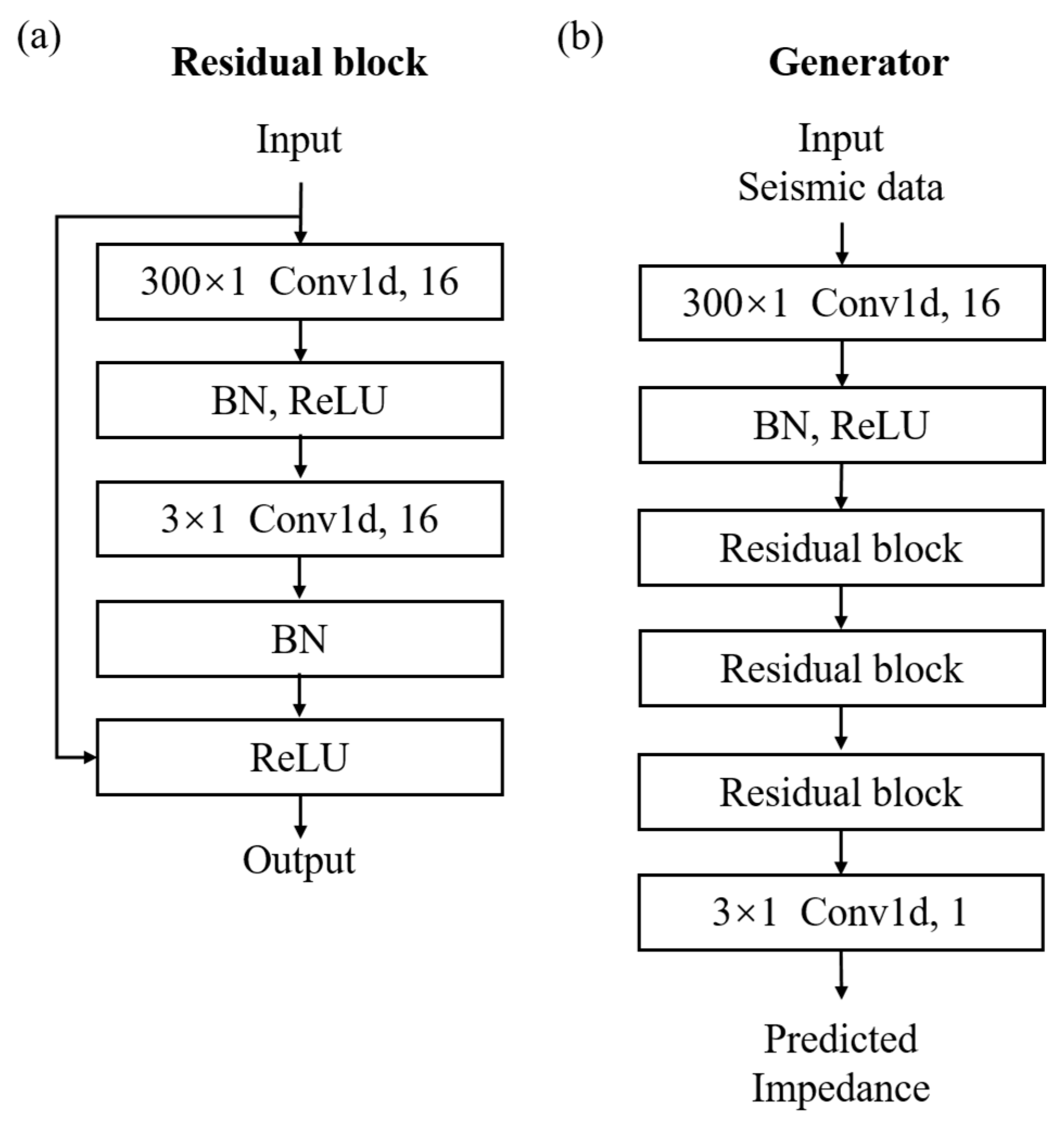
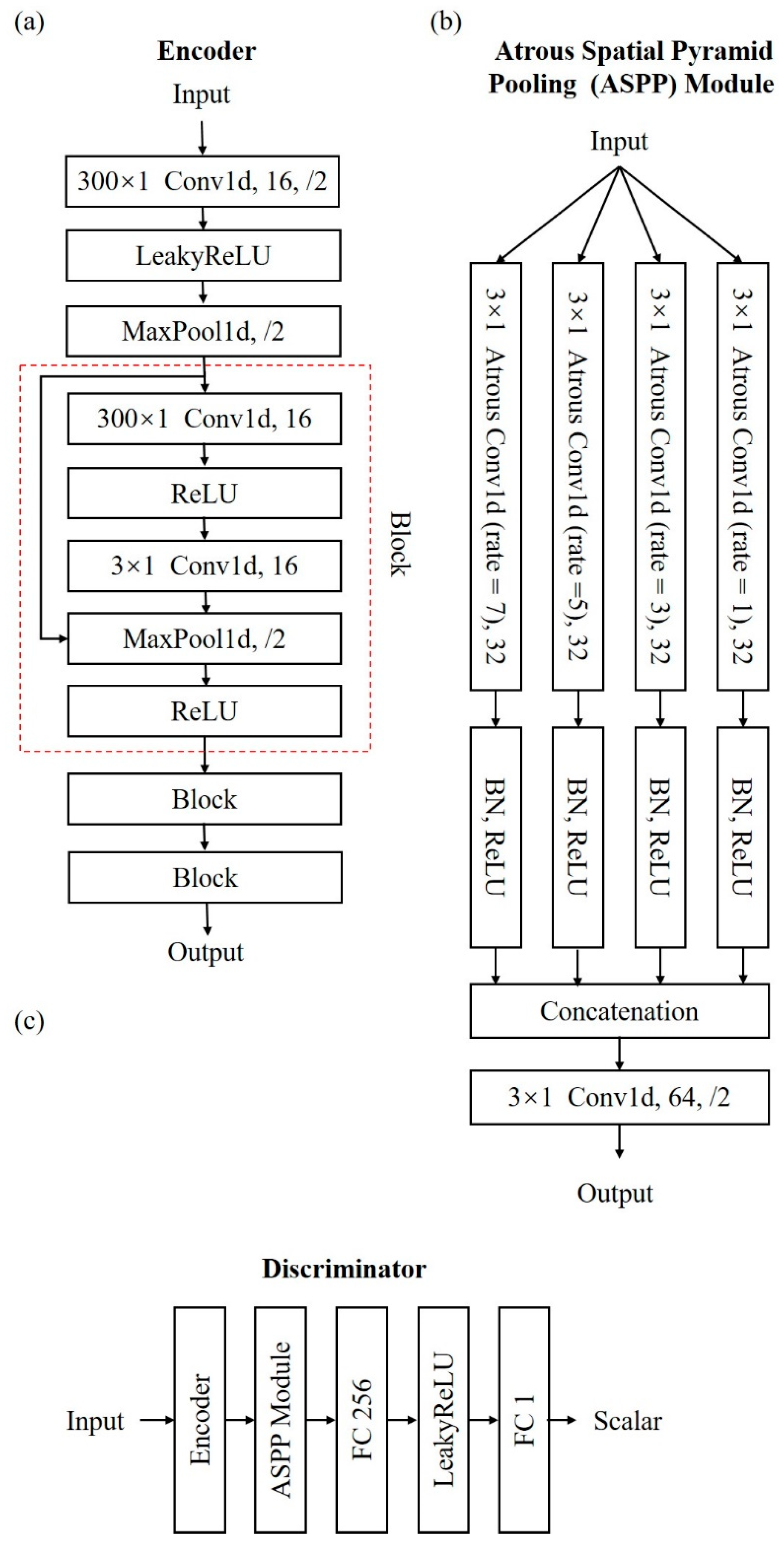

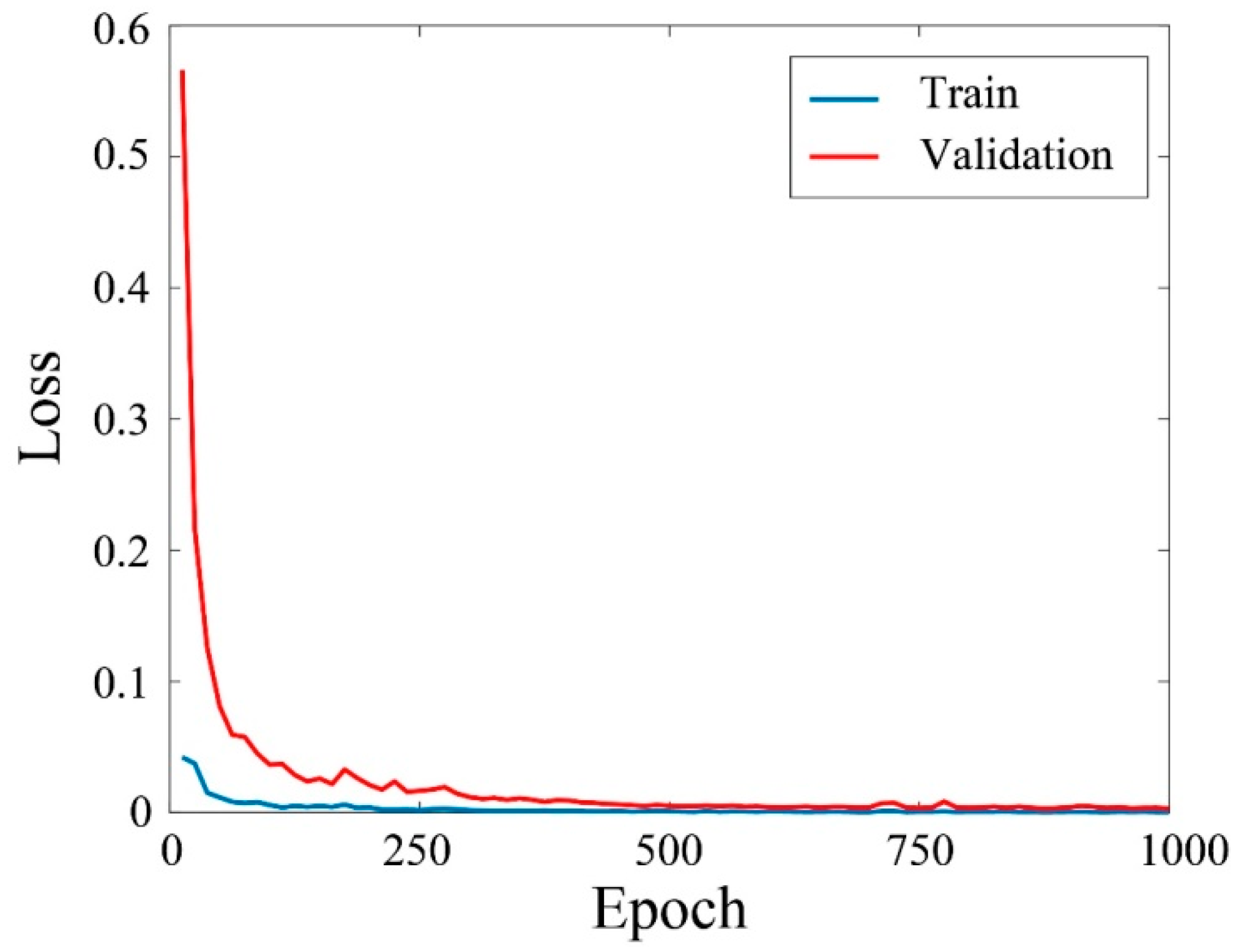
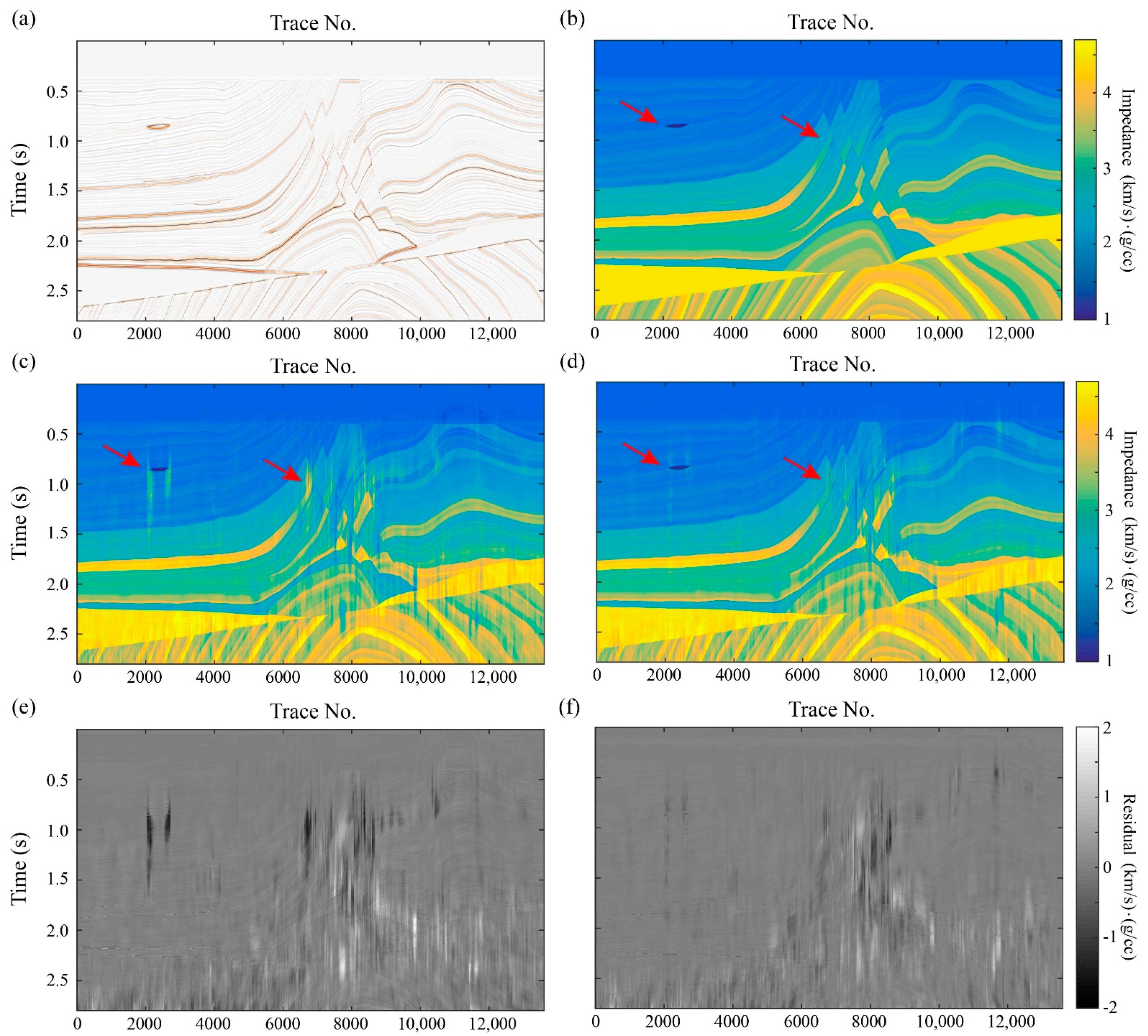


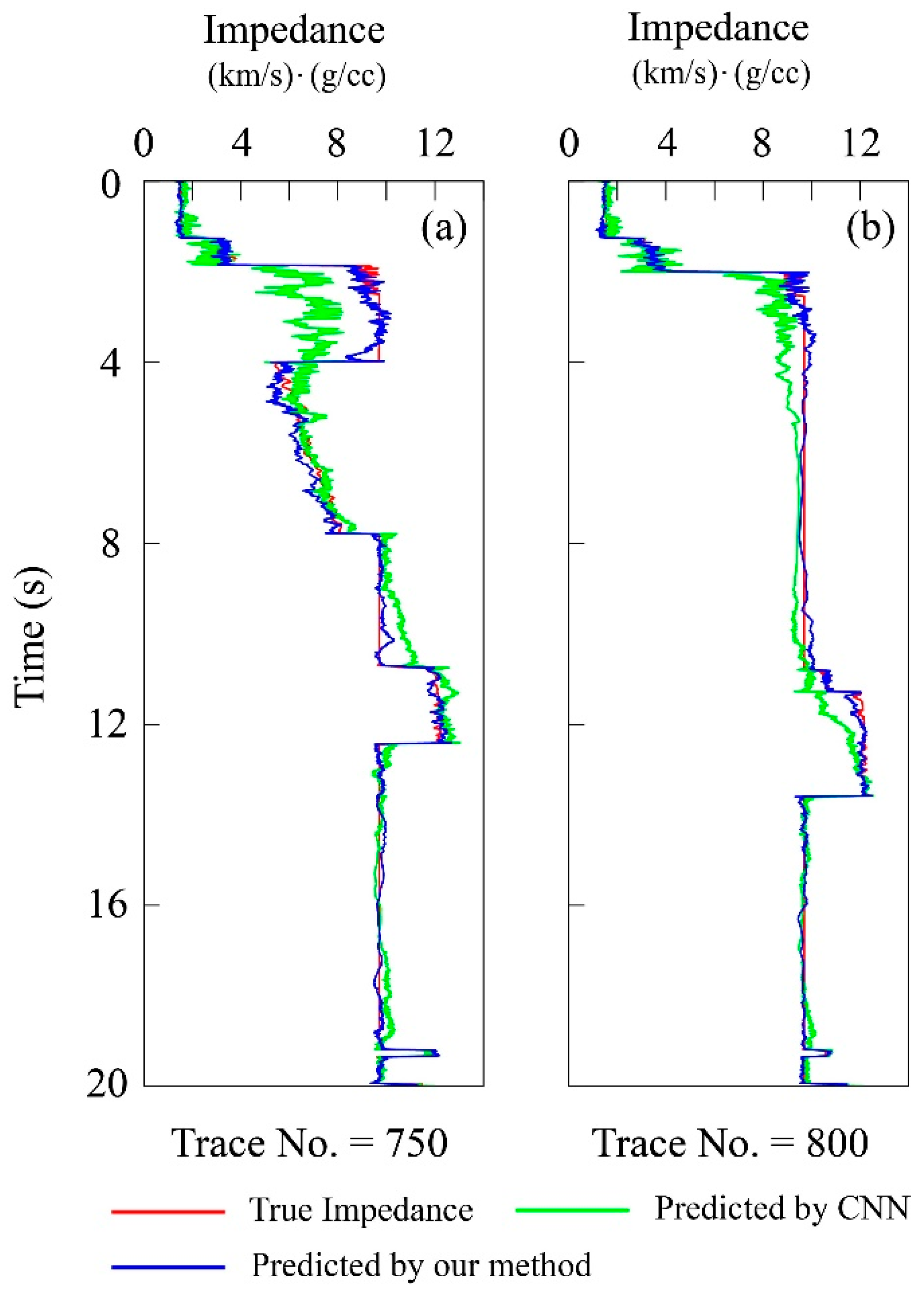

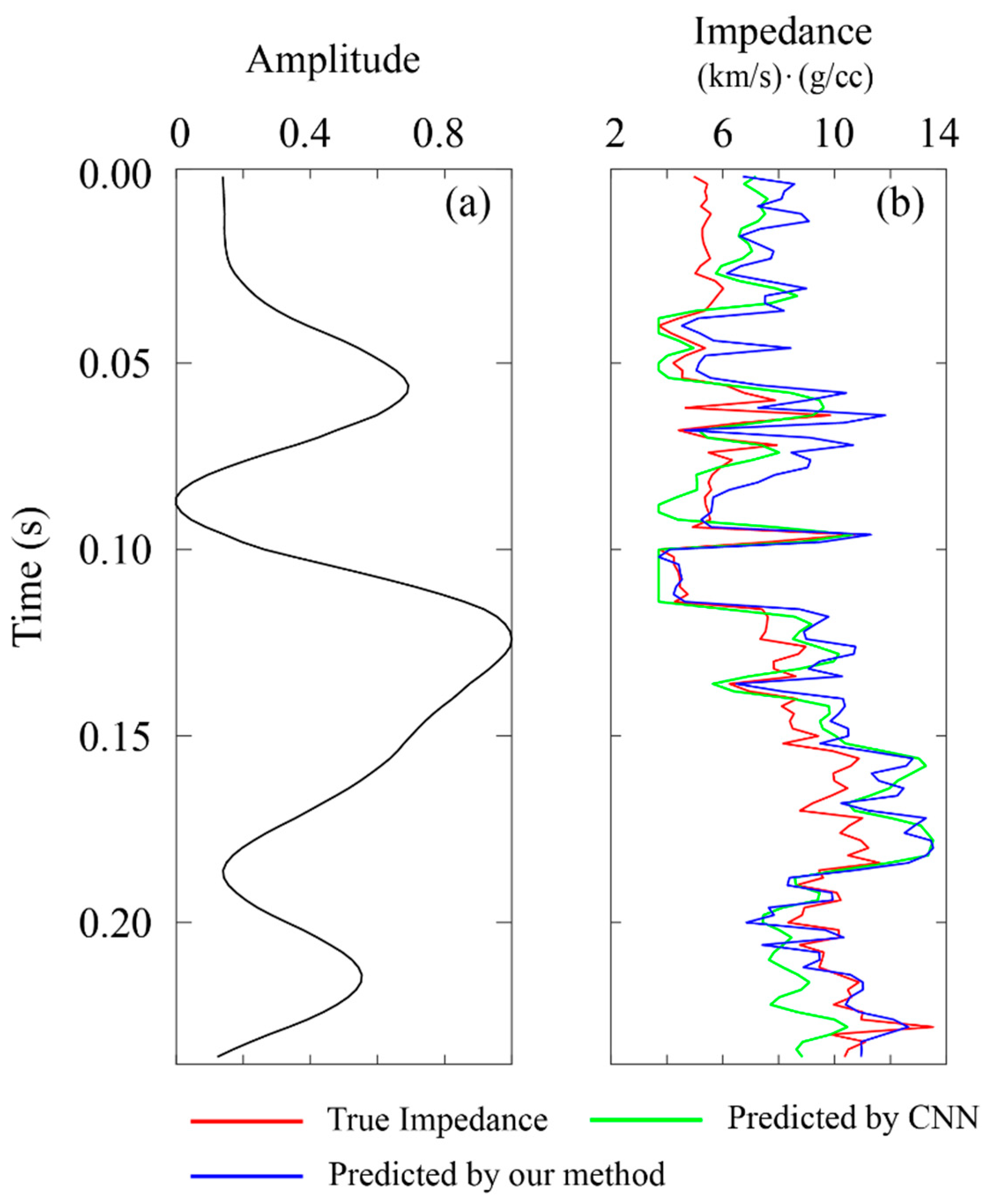
| Metric | Our Method | CNN |
|---|---|---|
| MSE | 0.0184 | 0.0332 |
| PCC | 0.9948 | 0.9938 |
| 0.9874 | 0.9847 |
| Metric | Our Method | CNN | Joint Learning 2-D TCN [16] | 2-D TCN [44] | 1-D TCN [26] | LSTM [44] |
|---|---|---|---|---|---|---|
| PCC | 0.9902 | 0.9770 | unavailable | 0.9259 | 0.9088 | 0.8526 |
| 0.9753 | 0.9436 | 0.8399 | 0.7977 | 0.6709 | 0.4738 |
Publisher’s Note: MDPI stays neutral with regard to jurisdictional claims in published maps and institutional affiliations. |
© 2021 by the authors. Licensee MDPI, Basel, Switzerland. This article is an open access article distributed under the terms and conditions of the Creative Commons Attribution (CC BY) license (http://creativecommons.org/licenses/by/4.0/).
Share and Cite
Wu, B.; Meng, D.; Zhao, H. Semi-Supervised Learning for Seismic Impedance Inversion Using Generative Adversarial Networks. Remote Sens. 2021, 13, 909. https://doi.org/10.3390/rs13050909
Wu B, Meng D, Zhao H. Semi-Supervised Learning for Seismic Impedance Inversion Using Generative Adversarial Networks. Remote Sensing. 2021; 13(5):909. https://doi.org/10.3390/rs13050909
Chicago/Turabian StyleWu, Bangyu, Delin Meng, and Haixia Zhao. 2021. "Semi-Supervised Learning for Seismic Impedance Inversion Using Generative Adversarial Networks" Remote Sensing 13, no. 5: 909. https://doi.org/10.3390/rs13050909
APA StyleWu, B., Meng, D., & Zhao, H. (2021). Semi-Supervised Learning for Seismic Impedance Inversion Using Generative Adversarial Networks. Remote Sensing, 13(5), 909. https://doi.org/10.3390/rs13050909






